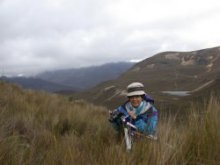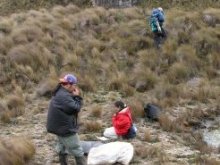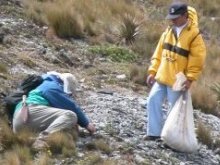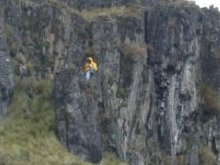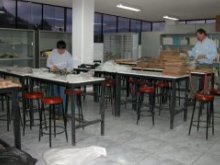 |
QUICK SEARCH
MO PROJECTS:
Africa
Asia/Pacific
Mesoamerica
North America
South America
General Taxonomy
Photo Essays
Training in Latin
America
MO RESEARCH:
Wm. L. Brown Center
Bryology
GIS
Graduate Studies
Research Experiences
for Undergraduates
Imaging Lab
Library
MBG Press
Publications
Climate Change
Catalog Fossil Plants
MO DATABASES:
W³MOST
Image Index
Rare Books
Angiosperm
Phylogeny
Res Botanica
All Databases
INFORMATION:
What's New?
People at MO
Visitor's Guide
Herbarium
Jobs & Fellowships
Symposium
Research Links
Site Map
Search
The páramo of El Cajas is located west of the city of Cuenca in Azuay province, in southern Ecuador (map). Páramo is a unique ecosystem dominated by bunch-grasses that has fascinated scientists since Alexander von Humboldt visited them more than 200 years ago; it is found between 8°N and 11°S latitudes above the tree line and up to the permanent snow line, from Venezuela to northern Peru and on a few mountains in Panama and Costa Rica. This ecosystem covers most of the area of Cajas National Park (CNP), but it also extends to the adjacent areas of Angas, Dos Chorreras, Migüir, Río Blanco, and Soldados. The word páramo was probably first used by the Spanish conquistadors when comparing these treeless inhospitable areas with the "parameras" of the Spanish province of Castile. The páramos, along with the Andean forests, function as a buffer in the hydrological cycle, which slowly releases the fallen rain water to rivers and lakes. The water captured in the páramos benefits millions of people that use it for consumption and irrigation. Páramos have high biological diversity and endemism, and constitute a unique biota. The species have adapted to the cold conditions, extreme solar irradiation, low atmospheric pressure, dramatic daily fluctuations in temperature, and seasonal rains. Many plants grow very close to the ground, forming rosettes and cushion-plants, or have reduced hard leaves or are covered with a dense layer of white or silvery hairs. CNP is one of the most popular sites of healthy recreation for the inhabitants of the province of Azuay, as well national and international tourists who visit the city of Cuenca. It is our hope that through this online publication we provide basic information about the flora for an adequate management of the area and for the pleasure of the general public who will appreciate the beauty of the species and their invaluable ecosystem. Let us not forget that the area of CNP is an important source of water for Cuenca and the Paute hydroelectric plant. The ecological well being of the Park is of extreme importance to the entire country. Methods
Participants of the expeditions were: Carmen Ulloa Ulloa and Peter Jørgensen, Missouri Botanical Garden, 2000-2003
Data bases Information presented in the checklist is an integration of the information deposited in the TROPICOS database of the Missouri Botanical Garden and the Herbarium database of the Department of Systematic Botany, Aarhus University, Denmark. © Carmen Ulloa Ulloa &
Peter M. Jørgensen, photographs.
|
© 1995-2025 Missouri Botanical Garden, All Rights Reserved
4344 Shaw Blvd.
St. Louis, MO 63110
(314) 577-5100
Technical Support
